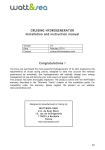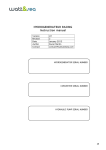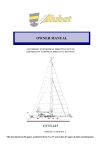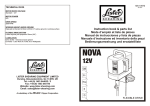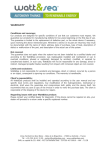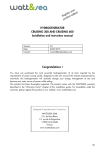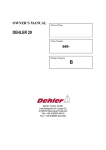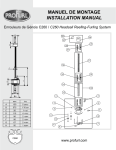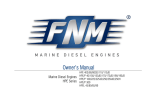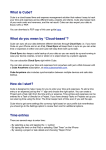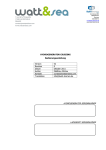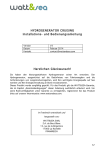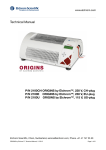Download HYDROGENERATOR SERIAL NUMBER
Transcript
HYDROGENERATOR CRUISING Instruction manual Version Revised Date Author Contact Translation V1 2 Décembre 2010 Matthieu Michou [email protected] HYDROGENERATOR SERIAL NUMBER CONVERTER SERIAL NUMBER TABLE OF CONTENTS 1. CONGRATULATIONS 4 2. SAFETY 2.1. Mechanicalhazard: 2.2. Electricalhazard 2.3. Installation 2.4. Operation 5 5 5 5 5 3. PACKAGE CONTENT 7 4. TOOLS & SUPPLIES NOT INCLUDED 7 5. MECHANICAL INSTALLATION 5.1. Installingthepropeller. 5.2. Placingthemachineonthetransom 5.3. Installingthecradleonthetransom. 5.4. Runningalineoftheimmersion/liftingsystem 5.5. Removingthepropeller 5.6. Mountingtheelectronicconverter 8 8 9 11 12 13 13 6. ELECTRICAL INSTALLATION 6.1. Three‐phaseswiringofthehydrogenerator 6.2. Connectingtheconvertertothebatteries 6.3. Replacingfuses 14 15 16 16 7. INSTALLATION SUMMARY 17 8. WARRANTY 18 9. CHARACTERISTICS 9.1. Technicalcharacteristics 9.2. Howitworks 9.3. Performances 19 19 20 21 10. MAINTENANCE 22 11. SPARE PARTS 22 12. F.A.Q. 12.1. Operation 12.2. Maintenance&repairs 12.3. Dockingormooring 23 23 23 24 W&S ‐ Manuel_GB_Cruise v1.2 page 2 by 24 BLUEPRINTS LIST Fig. Fig. Fig. Fig. Fig. Fig. Fig. Fig. Fig. Fig. Fig. Fig. Fig. Fig. 1: Package contents 2 : Shaft, propeller, plastic washer and M5 screw 3 : Installation on a 33’ Figaro II leant at 20° (CFD by CRAIN) 4 : Double installation on a Pogo40 (© CN STRUCTURES). 5 : Installation on a catamaran. (© OUTREMER CATAMARANS) 6 : Craddle dimensions 7 : Immersing/lifting lines path 8 : Device lifted in upper position 9 : Converter dimensions 10 : Drilling template 11 : Wiring 12 : Phase converter wiring plan. Arrows indicates phases in. 13 Hydrogenerator dimensions 14 : Output related to boat speed W&S ‐ Manuel_GB_Cruise v1.2 7 8 9 10 10 11 12 12 13 13 14 15 19 21 page 3 by 24 1. CONGRATULATIONS You own the most powerful hydrogenerator of its kind. Designed for transoceanic racing and cruising, this device will drastically change your energy management at sea and become your main source of power while sailing. Designed and made in France by: WATT&SEA SARL Le Sextant 1 rue de la Trinquette 17000 La Rochelle FRANCE www.wattandsea.com W&S ‐ Manuel_GB_Cruise v1.2 page 4 by 24 2. SAFETY “Safety first” was our goal in building the hydrogenerator. However precautions must be taken as when using any mechanical or electrical device. Keep in mind safety rules when installing and operating the hydrogenerator. Be aware at all times of hazards in operating the propeller. 2.1. Mechanical hazard : While rotating, propeller blades might be dangerous. They are aluminum made and their edges can rotate up to 62 MPH (100km/h). At this speed, the tip of a blade is nearly invisible and can cause serious injury. Under no circumstances should you install the turbine where a person could come in contact with moving rotor blades. WARNING: WHEN PLACING THE HYDROGENERATOR, MAKE SURE THAT THE PROPELLER IS NOT WITHIN EASY REACH. DO NOT ATTEMPT TO STOP THE PROPELLER WITH YOUR HAND WHILE THE DEVICE IS WORKING. 2.2. Electrical hazard Heat in wiring systems is often a result of too much current flowing through an undersized wire or through a bad connection. Batteries conduct very high intensity. Their cables might cause fire. A 50Amp fuse placed into the converter prevents this issue. WARNING: FUSES MUST BE REPLACED WITH THE SAME ORIGINAL MODEL WARNING: ALWAYS RAISE THE HYDROGENERATOR UP BEFORE WORKING ON IT 2.3. Installation Please follow our guidelines before installation: Keep safety in mind - Get helps. Connect the batteries last. 2.4. Operation Check the support structure, blades and electric circuit on a regular basis. Propeller blades are very sturdy though they might warp or break when running up against a hard immersed object. WARNING: NEVER TOUCH THE PROPELLER WHILE SPINNING WARNING: NEVER USE THE HYDROGENERATOR AS A LADDER STEP BECAUSE THE SHAFT MAY WARP. W&S ‐ Manuel_GB_Cruise v1.2 page 5 by 24 WARNING: ELECTRIC CONVERTER REACHES HIGH TEMPERATURE WHILE OPERATING. W&S ‐ Manuel_GB_Cruise v1.2 page 6 by 24 3. PACKAGE CONTENT Check the package content against the list below. 1 HYDROGENERATOR 1 THREE BLADE PROPELLER 1 CONVERTER 12V OR 24 V 1 SCREW CHC M4X16 1 SCREW CHC M6X16 1 INSTRUCTION GUIDE Fig. 1: Package contents 4. TOOLS & SUPPLIES NOT INCLUDED 3 phase cable 3X2,5mm2 minimum Quick Disconnect Terminals Crimp pliers Connectors for 3-phase cables Outlet box PCV Metric Allen wrench set Hubs & screws Gasket Ø 6mm W&S ‐ Manuel_GB_Cruise v1.2 page 7 by 24 5. MECHANICAL INSTALLATION Your hydrogenerator is shipped partly in kit. Refer to the assembly drawing below, and follow the instructions. Please carefully read the instruction manual before proceeding to the installation. 5.1. Installing the propeller. Slide the propeller onto the shaft Check that the electrolytic insulation washer is placed into its groove Insert the CHC M5X20 screw, and tight it with a 4mm Allen wrench. We recommend coating the screw with block thread to prevent the screw from loosening. Fig. 2 : Shaft, propeller, plastic washer and M5 screw N 2 8 12 21 Désignation Shaft Tri-blade propeller Insulation plastic washer Screw #CHC M5X16 W&S ‐ Manuel_GB_Cruise v1.2 page 8 by 24 5.2. Placing the machine on the transom Choosing the right place for the machine is crucial to optimize its performance. Be careful to respect the following conditions: Immersion depth: The recommended depth from surface to propeller axis is 30cm (12 inches). The machine comes with a profiled 1 meter aluminum bar that can be cut to fit any configuration. The deeper the device is located and the farther the propeller is from the hull wake, the better it is. However, the deeper the boom is, the more stress on mounting will result. In addition, the device will be harder to lift. We consider that a length of 1 meter (3.28 feet) is a satisfactory compromise that suits most installations on monohulls. A shorter length is suitable on multihulls because they don't lean, or on very wide monohulls when a device is installed on each side. Flow quality : A good water flow is crucial to a good output. . Example: installation using a long shaft (see drawing 3) . Example: installation using a short shaft (see drawing 4 & 5) NOTE: do not place the device in close proximity to the wake of rudder or saildrive. Whenever possible, install the device a few inches off the center of the boat. Example of installation with a 1 meter shaft: Fig. 3 : Installation on a 33’ Figaro II leant at 20° (CFD by CRAIN) W&S ‐ Manuel_GB_Cruise v1.2 page 9 by 24 Example of installation with shorter shafts (70cm): Fig. 4 : Double installation on a Pogo40 (© CN STRUCTURES). The hydrogenerators are placed parallel to the rudders but off their wakes. Fig. 5 : Installation on a catamaran. (© OUTREMER CATAMARANS) The hydrogenerator is placed parallel to the rudder but off its wake. W&S ‐ Manuel_GB_Cruise v1.2 page 10 by 24 5.3. Installing the cradle on the transom. Depending on your transom structure and to ease stress on the cradle plate, you might need to reinforce the structure of the transom. WARNING : Because the lever arm is important, the maximum effort in cradle’s fixations is around 300 kg (661 pounds). Your mounting system should be designed accordingly. The cradle must be fastened to 8mm chainplates that will be securely mounted on the transom. Chainplates must be placed vertically. Use the drawing below to adapt the mountings to your boat. NOTE: when immersed in working position, the shaft must be vertical. Fig. 6 : Craddle dimensions W&S ‐ Manuel_GB_Cruise v1.2 page 11 by 24 5.4. Running a line of the immersion/lifting system Your hydrogenerator comes with a lifting system designed after lifting rudders systems. It allows easy access to the propeller when the device is in upper position, which allows weed cleaning without leaning over board. We recommend inserting a self-release clam that will release the device when running against an immersed hard object. Immersion and lifting are performed with 2 lines attached into specific eyelets. Fig. 7 : Immersing/lifting lines path Lifting weight is around 40 kg (88 pounds). We recommend to placing a 4:1 pulley hoist for easier lifting of the device, and a 6:1 for the lowering line on the cruising model. Fig. 8 : Device lifted in upper position W&S ‐ Manuel_GB_Cruise v1.2 page 12 by 24 5.5. Removing the propeller To remove the propeller, you should use a M6 screw as an extractor tool. Unscrew the M5 screw that holds the propeller at the very end of the shaft. Next, insert a M6 screw and tighten it with the appropriate wrench; this extracts the propeller effortlessly from the conic shaft. 5.6. Mounting the electronic converter The electronic converter is fitted into a waterproof box that features passive ventilation allowing long durability of the device in a humid environment. However this converter must be affixed inside the boat, preferably near the battery to be charged. WARNING: THE CONVERTER CAN REACH A HIGH TEMPERATURE WHILE OPERATING. TAKE THIS INTO CONSIDERATION FOR ITS INSTALLATION NOTE: To allow proper ventilation, the converter must be mounted on a vertical bulkhead, with ventilation grids in vertical position Once a proper place is designated, follow this procedure: Drill 4 holes using the provided template Remove the cover (4 M6 screws) Secure the device in place with the appropriate screws Put the cover back in place with its gasket. NOTE: Carefully put the gasket back in place Fig. 9 : Converter dimensions Fig. 10 : Drilling template W&S ‐ Manuel_GB_Cruise v1.2 page 13 by 24 6. ELECTRICAL INSTALLATION Recommendations regarding electric connections: Please follow local/national safety rules before installation. All electric cables must be carefully insulated. For the highest safety, insert cables into plastic conduits. WARNING: CONNECTIONS MUST BE CHECKED ON A REGULAR BASIS TO DETECT ANY EVIDENCE OF CORROSION, AND CLEANED WHEN NECESSARY. ) ed d clu d) de u l in c t t in no ( o n le ( ox cab b er e n as ert tio h v c p 3con jun tt ba ery Fig. 11 : Wiring W&S ‐ Manuel_GB_Cruise v1.2 page 14 by 24 6.1. Three‐phases wiring of the hydrogenerator WARNING: LIFT THE GENERATOR UP BEFORE ANY OPERATION The hydrogenerator comes with a small diameter electric cable located at the bottom, long enough to get through the transom. This cable features a 3-phase wiring identified in black, brown and grey colors. A green & yellow wire can be found for ground. After this transom point, connect a tri-phase cable of a larger section (minimum 3X2.5mm2) between the hydrogenerator and the converter. NOTE: a cable of a smaller section than 3X2.5mm2 will affect the output of the device as well as its performance. We recommend to connect the cables in a designated outlet box inside the boat to allow a better prevention against corrosion. You may use this kind of connector that absorbs well vibrations and features a quick release connexion : WAGO 222-412 The converter is connected with Quick Disconnect Terminals (Fast-on) of 6.35mm. First open the converter box, pass the tri-phase cable through the gasket hole, then crimp the Quick Disconnect Terminals and connect them to their terminals. Fig. 12 : Phase converter wiring plan. Arrows indicates phases in. NOTE : The converter is equipped with connections for 2 hydrogenerators. The 6 terminals are indifferent. NOTE: phase order is not important W&S ‐ Manuel_GB_Cruise v1.2 page 15 by 24 6.2. Connecting the converter to the batteries The converter must be placed as close as possible to the batteries to minimize losses from cable length. We provide 2 meter long connecting cables for batteries. We recommend shortening any extra cable to reduce losses. If the installation needs an overall distance of more than 2 meters (6 feet), extend the cables with wider section ones, or replace them entirely with wider section cables. We recommend connecting the hydrogenerator directly to the battery bank on its proper terminal. The converter of the hydrogenerator will charge the batteries when needed. Connecting the hydrogenerator through a hub is possible if charging several battery compartments is needed. Nevertheless those systems affect the output and a loss of about 5% will result. An electric arc might occur when connecting: this is normal, due to the charging of the condensers into the converter. WARNING: respect the converter polarity: positive from converter to battery positive, and converter negative to battery negative. Inverting the polarity will result into the fuse to blow, and might ruin the device itself. 6.3. Replacing fuses Converter is protected by a 50A fuse commonly used in car industry. When a fuse blows, you should first figure out the reason of the problem and solve it before replacing the fuse. How to replace a fuse: Disconnect the converter from the batteries Open the cover by removing the 4 M6 screws Replace the fuse Close back the cover with its gasket Reconnect the batteries. WARNING: carefully put the gasket back in place. W&S ‐ Manuel_GB_Cruise v1.2 page 16 by 24 7. INSTALLATION SUMMARY Here follows the installation procedure of the hydrogenerator, step by step. This document should be used only as a quick guideline for the installation. Please go to the appropriate sections through this manual for detailed instructions. 1. Mount the propeller. Refer to chapter 5.1 2. Install the hydrogenerator on the transom. Refer to chapter 5.3 3. Fit a Ø 6mm gasket in the transom to bring tri-phase cable inside the boat 4. - Mount an outlet box on or near the transom inside the boat 5. Mount the converter on a vertical bulkhead, the closest possible to the batteries 6. Lay the power cables from battery to the converter, then the three-phases cable from the converter to the transom outlet box DO NOT CONNECT the cables to the batteries until the installation is completed 7. Connect the phases of the tri-phase cables into the outlet box Make sure the propeller is not immersed and the alternator can't work during the installation. 8. Open the converter cover. Pass the tri-phase cable through the gasket. Crimp the Quick Disconnect Terminals and plug them to the rectifiers. Refer to chapter 6.2 Connecting the converter to the batteries . 9. Connect the batteries cables: the red marked one to the positive, black to the negative. An electric arc might occur at the time of connection, this is normal: it is due to the condensers charging into the converter. 10. Once the converter is connected to the positive battery buss (direct to the battery with lead/gel/agm, or to the positive "charging buss" of a lithium battery system), the microprocessor will light a red LED, showing that the converter is properly working. When the propeller reaches 400 rpm, the hydrogenerator starts to charge and the LED turns green. W&S ‐ Manuel_GB_Cruise v1.2 page 17 by 24 8. WARRANTY Conditions and coverage: Our products are designed for specific conditions of use that our customers must respect. We guarantee our products for manufacturing defects for two years beginning on the first day of use. The guarantee is limited to the replacement of defective part, or the whole device if necessary, upon receiving the above mentioned part. Whenever a device or its part are returned, they must be documented with the name of client, address, date of purchase, type of boat, description of defect or malfunction of the part, and description of the actual use of the system. Not covered: The guarantee does not apply when the system has not been installed by a certified dealer and according to the WATT&SEA procedure; was inadequately installed and maintained or use in overload conditions; abused or neglected; damaged by accident, modified, or repaired by unauthorized dealers. In such case, WATT&SEA will not be responsible for any damage, direct or indirect. Damaged propeller blades resulting from impact with immersed object are not covered. Limits and exclusions: All guarantees for WATT& SEA products are limited in time are hereby mentioned: WATT&SEA is not responsible for accidents and damages, direct or indirect, incurred by a person or persons, consequent to ignoring our conditions. This warranty is transferable. Clientʼs responsibility: All WATT&SEA products shall be installed and operated according to the user manual and any specific local norms and regulations. Any modification of the hydrogenerator, mechanical or electrical, shall wave the guarantee and compromises both safety and the device itself. We recommend that you save a copy of the invoice in order to verify the purchase date. The client is responsible of the shipping of the device for repairs. Regarding issues with your WATT&SEA product: Please contact your certified dealer for diagnostic. If the device cannot be repaired on site, your dealer will proceed to a return under a specific registered number. W&S ‐ Manuel_GB_Cruise v1.2 page 18 by 24 9. CHARACTERISTICS 9.1. Technical characteristics Hydrogenerator : Nominal power : 500W Voltage : 3-phase 40V Current : 9A Weight : 9.1kg (20 pounds) Dimensions : 1150 x 500 x 240 mm (10.2 In x 7.1 In x 5.1 in) Converter : Nominal power : 500W Regulated voltage : 14,4V/28,8V Current : 40A/20A Weight : 5,5kg Dimensions : 260 x 180 x 130 mm (45.3 In x 197 in x 9.5 in) PROFIL EXTRUDÉ LONGUEUR VARIABLE Fig. 13 : Hydrogenerator dimensions W&S ‐ Manuel_GB_Cruise v1.2 page 19 by 24 9.2. How it works The hydrogenerator: It includes a permanent magnet alternator producing very low 3-phase current. This technology allows high efficiencies, but also generates high voltage during over-speed. To prevent tension from surging over 40V, an electronic protection cuts off the voltage above 40V. This circuit is imbedded into the body of the hydrogenerator, and thus protects the output. Protection against overvoltage, some notes: When the device works over-speed, it produces a specific and audible rumble. This can occur for several reasons: 1 – A cable has been disconnected or the fuse blew and the converter is not anymore linked to the batteries. The device runs 'freewheel' and is not slowed down anymore by the electromagnetic force. 2 – Batteries are charged or the battery capacity is too weak. The converter has completed charging the batteries or the batteries can't absorb enough energy to slow down the propeller. 3 – The boat sails over the propeller speed range and the converter is stuck to its maximum capacity. If the additional drag and the resulting sounds that come with it don't bother you, you can keep on going. The converter: The converter turns the alternating current coming from the alternator into a continuous current compatible with the batteries. The maximum voltage is reached only when the batteries are fully charged. In normal working conditions, the voltage is lower than 14.4 V 28.8V. The "Soft START" feature: The device features a progressive starting that allows effortless immersion. You have therefore about 10 seconds to bridle tight it before the converter begins working and the propeller generates a drag. W&S ‐ Manuel_GB_Cruise v1.2 page 20 by 24 9.3. Performances As detailed in Chapter Fehler! Verweisquelle konnte nicht gefunden werden., the performance strongly depends upon the right location on the transom, the quality of water flow and the speedometer calibration. The chart below shows performances measured on a power boat equipped with Ø 24 cm and Ø 28 cm propellers. Fig. 14 : Output related to boat speed W&S ‐ Manuel_GB_Cruise v1.2 page 21 by 24 10. MAINTENANCE The hydrogenerator has been designed for offshore races and benefits from the latest technology for its reliability. Metallic parts are made either in specially treated aluminum or in stainless steel A4. The best sealing is obtained with a hi-tech ceramic-carbon gasket used in industry. These gaskets have a lifetime of several thousands of hours and will painlessly support a circumnavigation. The body is filled with lubricating oil that is slightly pressured to prevent any water seepage. In addition, the alternator is factory immersed in a resin that encapsulates electrical conductors. Should dampness occur, the electric parts are resistant to damage. Therefore, this device does not need any particular maintenance other than cleaning external parts. Checking oil level might be needed from time to time. Regularly clean the body of the device Verify on a regular basis that the device mountings are tight Check that all the electrical connections are tight and clean (not corroded) Do not operate the hydrogenerator with damaged or unbalanced propeller blades. This might cause a premature wear, or a break down. Replace the propeller as soon as possible. 11. SPARE PARTS WS-H-C- 001 Cruising hydrogenerator WS-CV-C-12 12 Volts converter WS-CV-R-24 24 Volts converter WS-K-C-001 Aluminium craddle WS-H-C- 001 Propeller WS-N-C-001 Manual W&S ‐ Manuel_GB_Cruise v1.2 page 22 by 24 12. F.A.Q. 12.1. Operation What power output can I expect? The power generated increases at the cube of the speed (V3). At 5 knots, the output power is about 120W (or about 10A on a 12V battery raw) with the 280mm propeller. At 8 knots, the system produces 4 times more power, i.e. 480W (about 40A on a 12V battery raw). These figures are instantaneous measurements and averages might be different according to the condition at sea. What speed loss is to be expected? We currently don't have any reliable data on the effective drag of the device, or about the speed loss it generates. Our immersion and lifting trials at constant speed have not shown any substantial difference on the speedometer. What happens when the batteries are charged? The electronic regulator automatically charges the batteries. When the batteries are fully charged, the propeller switches to "freewheel" which diminishes the drag. What happens in case of impact? The lifting system allows inserting a fuse that will release the device in case of impact. However, risk of direct impact on the device is minimal given its position on the transom, behind the keel, centerboard, and rudder. Can I use the device while I run my boat main engine? The system in not designed to replace the alternator of your engine. It can nevertheless be used while operating your main engine, though the output may be lower because of the engine propeller turbulences. 12.2. Maintenance & repairs How reliable the system is? The hydrogenerator has been designed for offshore races and benefits from the latest technology for its reliability. Metallic parts are made either in specially treated aluminum or in stainless steel A4. The best sealing is obtained with a hi-tech ceramic-carbon gasket used in industry. These gaskets have a lifetime of several thousands of hours and will painlessly support a circumnavigation. The body is filled in with lubricating oil slightly pressured to prevent any water seepage. In addition, the alternator is factory immersed in a resin that encapsulates electrical conductors. Should dampness occur the electric parts would not be damaged. What is the anti-corrosion treatment? The aluminum parts are anodized, and coated with paint. They are also electrically insulated from the other metallic parts to prevent electrolytic corrosion. W&S ‐ Manuel_GB_Cruise v1.2 page 23 by 24 How should I maintain the device? Except for cleansing the exterior body, the device does not require any specific maintenance. Checking oil level might be needed from time to time. Can I replace the propeller? Disposing the propeller is simple and only requires an Allen wrench and an extractor screw. 12.3. Docking or mooring What should I do? You may either leave the device on the transom in upper lift position, or store it away in your cockpit locker if you own a portable model. If not lifted, it is necessary to have “limiting” lines to prevent the cradle and blade from backing against the transom causing damage. However it is highly recommended to simply raise the device. W&S ‐ Manuel_GB_Cruise v1.2 page 24 by 24
























